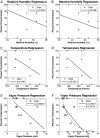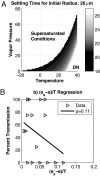Absolute humidity modulates influenza survival, transmission, and seasonality
- PMID: 19204283
- PMCID: PMC2651255
- DOI: 10.1073/pnas.0806852106
Absolute humidity modulates influenza survival, transmission, and seasonality
Abstract
Influenza A incidence peaks during winter in temperate regions. The basis for this pronounced seasonality is not understood, nor is it well documented how influenza A transmission principally occurs. Previous studies indicate that relative humidity (RH) affects both influenza virus transmission (IVT) and influenza virus survival (IVS). Here, we reanalyze these data to explore the effects of absolute humidity on IVT and IVS. We find that absolute humidity (AH) constrains both transmission efficiency and IVS much more significantly than RH. In the studies presented, 50% of IVT variability and 90% of IVS variability are explained by AH, whereas, respectively, only 12% and 36% are explained by RH. In temperate regions, both outdoor and indoor AH possess a strong seasonal cycle that minimizes in winter. This seasonal cycle is consistent with a wintertime increase in IVS and IVT and may explain the seasonality of influenza. Thus, differences in AH provide a single, coherent, more physically sound explanation for the observed variability of IVS, IVT and influenza seasonality in temperate regions. This hypothesis can be further tested through future, additional laboratory, epidemiological and modeling studies.
Conflict of interest statement
The authors declare no conflict of interest.
Figures




Comment in
-
Influenza seasonality: lifting the fog.Proc Natl Acad Sci U S A. 2009 Mar 10;106(10):3645-6. doi: 10.1073/pnas.0900933106. Proc Natl Acad Sci U S A. 2009. PMID: 19276125 Free PMC article. No abstract available.
References
MeSH terms
LinkOut - more resources
Full Text Sources
Other Literature Sources
Medical

